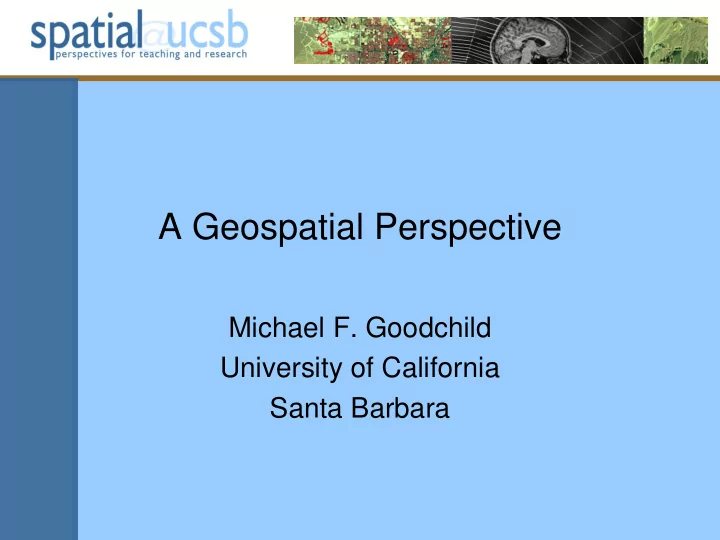

A Geospatial Perspective Michael F. Goodchild University of California Santa Barbara
Embedded social networks • Embedded in geographic space (and time) • What can we learn from the embedding? • What constraints does the embedding impose? • What do we know about embedded systems that can inform research?
Geospatial technologies • GPS – measurement of position is now trivial • Remote sensing – massive resources of imagery – ubiquitous, fine-resolution base maps – near real-time • days • Geographic information systems – formal methods of representation – analysis and modeling
Interoperability • Easy exchange of data – primarily syntactic • Formal and informal location referencing – 120.12456 W, 34.89176 N – 909 West Campus Lane, Goleta, CA 93117, USA – 5789654N, 314654E, Zone 11, Northern Hemisphere – NE 1/4, Section 12, Township 23 Range 5 of the Second Principal Meridian – National Grid reference 11SKU36151156 • Mike Goodchild's house
Weaknesses • Time – legacy of static map-based information • 3D – recorded elevation (2.5D) – lack of support for full 3D structures • Binary knowledge
Spatial knowledge • Knowledge about properties z present at locations x in space-time ( unary knowledge) – expressed as maps • when that knowledge is relatively static in time – increasingly dynamic • Knowledge about the properties z of pairs of places in space-time x 1 , x 2 ( binary knowledge) – e.g. distance, social affinity and interaction, travel time, flow, proximity – not ideally suited to mapping
* 0..1 0..2 * 0..1 Generic Flow Model Glennon, TGIS 2010
Links • Real or implied • Attributed • Directed • Planar or non-planar
Geospatial data modeling • Point, line, area classes – attributes and methods • Association classes – attributes of pairs of objects
Learning from embedding • Inferences from spatial and spatiotemporal form – footprints of process • Context – vertical • what else is known about this location? – horizontal • what is known about nearby locations? • TFL
Laws of geography • Nearby things are more similar than distant things – spatial dependence – distance decay • Spatial heterogeneity – statistical non-stationarity – uncontrolled variance – spatial sampling designs
1843 map of London from David Rumsey collection Pump and death locations from Snow
Source: Mason et al., Atlas of Cancer Mortality for U.S. Counties , NCI, 1975
Swing rebellion of 1832
Daily patterns of georeferenced tweets, Los Angeles, August 2010
Distance decay • A general pattern observed in processes embedded in geographic space I O D e bd ij i j ij • Wilson: the most likely distribution of interaction with distance if the total or mean distance is known • Darren Hardy’s work on Wikipedia authorship
Robinson projection Articles with geotags 988,522 articles 103,291 distinct locations # of articles per unit area (log scale, 0.1° resolution)
Wikipedia authorship Contributions to “Copenhagen Opera House” • Registered authors # of Username or IP Most Recent Contributions • Only username required 18 Dybdahl 18-Sep-2005 6 85.233.237.71 (anon) 12-Jan-2008 3 Viva-Verdi 8-Sep-2006 • Name, email, etc. optional 1 Hemmingsen 3-Jan-2007 4 81.62.92.47 (anon) 15-Apr-2006 • IP address kept hidden 1 Thue 28-Feb-2006 2 Ghent 30-Apr-2006 3 Valentinian 7-Jan-2007 • Anonymous authors 3 83.77.92.205 (anon) 10-Apr-2006 3 130.226.234.229 (anon) 29-Sep-2007 2 86.149.109.196 (anon) 15-Oct-2007 • IP address made public 2 Uppland 24-Dec-2005 2 87.48.100.222 (anon) 12-Jan-2006 • But nothing else
University of California, Santa Barbara 135 anonymous authors with 719 revisions; signature distance = 533 km
64% of articles at 2,000 km or less ???
A mixture? • Negative exponential distance decay – for some entries – driven by familiarity, proximity-based interest – some fraction of contributors α • Flat – b goes to 0 – the death of distance – some fraction of contributors 1- α
The embedding space • Invert to infer distance 1 d log I O D ij ij i j b • Scale to obtain a space
Recommend
More recommend